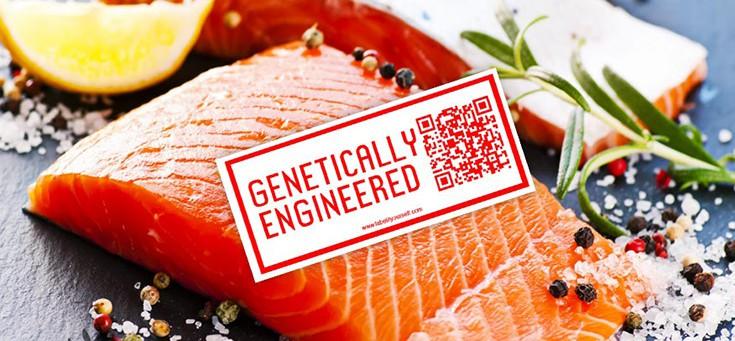Bad news! The US Food & Drug Administration (FDA) recently approved the first genetically modified food animal, an Atlantic salmon that grows twice as fast as natural salmon, with the insertion of genes from Chinook salmon and eelpout, an eel-like fish. Healthy solution: Buy wild Alaskan salmon.The FDA Approves Genetically Engineered Salmon – Here’s What You Need To Know, By Dr. Joseph Mercola. Re-printed from Wake-upworld.com
As a result, they carry three copies of each chromosome instead of two. But that’s not the only change. Their sex hormones will also undergo complicated manipulation to ensure they’re all female. They’re also said to be sterile, as an added precaution should they manage to escape, but the sterilization process has been criticized as flawed, and not 100 percent guaranteed.
Adding insult to recklessness, the FDA will not require any additional labeling identifying the genetically aberrant nature of this salmon. The news of the approval was shocking to many, considering the strong opposition to it, and undoubtedly resulted in more than a few exasperated facepalms.
Critics Have Long Raised Serious Questions About Human and Environmental Safety
The FDA claims there’s “reasonable certainty of no harm” coming from eating Aquabounty’s “Frankenfish.” Even the Center for Science in the Public Interest (CSPIhas gone on record saying the genetically engineered (GE) salmon is safe to eat and will not harm the environment.
But on what, exactly, are these opinions based? As noted by Food Democracy Now!:
“… Approval of AquaBounty’s genetically engineered salmon was done using only the company’s own shoddy scientific studies, which were so poorly designed they wouldn’t pass a 5th grade science fair.
For two of the studies submitted, AquaBounty used sample sizes so small that they have no scientific credibility, with only 12 fish tested for one study, while another study on possible allergic reactions in humans involved only six fish!”
They’re far from alone in their critique. In a 2011 interview, [4] Professor Anne Kapuscinski of Dartmouth College, an environmental scientist and scientific adviser to the government on transgenic organisms noted:
“My main concern was that the kind of data presented [by Aquabounty] had gaps, and the quality of the analysis of the data, especially the statistical analysis, was really quite a low bar…
I was concerned that there were some problems with small sample sizes, some problems with statistical analysis, and I was even more concerned that there were key parts missing from the risk assessment.
It seemed like the approach taken, the risk assessment, wasn’t really up to speed with the state of the art risk assessment.”
Wait… Is It a Fish, or a Drug?
But that’s not all. The FDA is not regulating Aquabounty’s salmon as food. It chose to review it as a drug.
That’s right, all GE animals, starting with this GE salmon, will be regulated under the new animal drug provisions of the Federal Food, Drug, and Cosmetic Act, “because the recombinant DNA (rDNA) construct introduced into the animal meets the definition of a drug.”
Yet the reason it puts forth for not requiring a label is that it’s nutritionally equivalent to conventional farm-raised Atlantic salmon. So which is it — a fish or a drug?
In the eyes of the FDA, it’s a perfectly normal fish, but it’s also a drug, but since it’s a fish that is comparable to other fish, it doesn’t need to be labeled, even though all drugs typically need to be labeled… Figure that one out if you can!
It’s worth reiterating that the alleged nutritional equivalence is that of farm-raised salmon, not wild.
And studies have shown there are significant nutritional differences between farmed and wild salmon, and as for the labeling issue, we have labeling requirements to distinguish between farmed and wild too. But not for this sterile, genetically engineered, all-female lab-created salmon.
Why Regulating GE Animals As Drugs Is a Bad Idea
It’s important to realize that regulating this fish (and any subsequent GE food animals) as a drug rather than a food has implications. As previously noted by Food and Water Watch:
“The FDA has gotten it wrong from the very beginning: it chose to regulate GE salmon as it would regulate a drug, not a food — even though consumers could end up eating it.
This means that the FDA is not comprehensively examining many critical dimensions surrounding the food safety of GE salmon as an actual food product for human consumption.
Independent scientists have criticized the risk assessment for GE salmon due to the agency’s heavy dependence on very small sample sizes. Using only a handful of GE salmon in their assessment makes the FDA’s subsequent statistical analysis questionable at best.
Their analysis did demonstrate that their small sample of GE salmon showed 40 percent higher rates of a hormone linked to cancer and 20 to 50 percent higher allergenic rates — along with higher rates of physical deformities in GE salmon.
But the FDA’s conclusion focused on the fact that it could not detect a difference between GE and non-GE salmon. This is how they determined that GE salmon is safe.”
In a 2010 letter to the FDA, the group notes:
“The fish exhibits a multitude of material differences, evident in measures of allergenicity, hormone levels, fatty acids, amino acids, vitamins, and minerals. In fact, in every food safety aspect considered by the FDA, the agency found double-digit differences between GE salmon and control groups.
Disconcertingly, as members of the FDA’s Veterinary Medicine Advisory Committee repeatedly pointed out during their meeting in September, the FDA’s scientific approach and statistical analysis were conducted in such a way that these differences went largely unacknowledged and unexamined by the agency.
But even the pervasive flaws in the FDA’s process cannot mask the ubiquitous differences in GE salmon. Of the 60 nutrition analytes that the FDA considered… more than a third of these showed double-digit differences compared to control groups. And the GE salmon exhibited triple-digit differences in four fatty acids.
Indeed the overall picture from the data is one of GE salmon being high in fat — though not higher in beneficial omega fats-and lower in protein. Because salmon are prized for having high protein content and healthy fat levels… these differences are of particular interest to consumers.”
FDA Does Not Have a Track Record of Correctly Assessing Health Threats
Both the FDA and CSPI have a history of being wrong. Both were wrong about trans fats, for example, but the truth didn’t become fully apparent until decades had passed and tens of thousands of people had died from heart disease as a result of eating a trans fat-laden diet. CSPI purports to be a consumer watchdog group focused on nutrition and food safety, but history shows they’re seriously misguided when determining what’s in the public’s best interest.
As for the FDA, it has become little more than a rubber-stamping agency for food and drug industry experiments. At one point, “FDA Approved” actually meant something, but those days are long done. It’s truly shocking that, right in the midst of rising scientific concern about genetically modified organisms (GMOs), the FDA ignores all warning signs and approves a genetically engineered food animal, and without a labeling requirement to boot!
As reported by Reuters: [8]
“The approval for the fish, to be sold under the AquAdvantage brand, requires that the salmon be raised only in two designated land-based and contained hatcheries in Canada and Panama, and not in the United States. All of the fish will be female, and reproductively sterile, to prevent inadvertent breeding of the genetically modified fish with wild salmon, FDA officials said.
The agency on Thursday also issued draft guidelines on how food manufacturers could identify whether the salmon in their products are genetically modified. The guidelines state that such labeling would be voluntary.”
For more information, please see: What Does FDA-Approved GMO Salmon Mean for Our Health?
Approval of GE Salmon Intensifies Opposition
Following the approval, Food and Water Watch announced it is talking to members of Congress about rolling back the approval. If that doesn’t work, the group may file a lawsuit to block the fish from getting to market. Some retailers have already pledged to not carry the GE salmon, including Kroger Co., Safeway, Trader Joe’s, and Whole Foods Market.
The Center for Food Safety has also vowed to sue the FDA over the decision, and environmental groups have already filed suit against the Canadian government. As reported by Newsweek, the groups argue that: “the permission granted to AquaBounty Technologies to cultivate its AquAdvantage salmon eggs on Prince Edward Island was too wide in scope and would allow other GM animal companies to do the same without proper oversight.”
According to Friends of the Earth, an estimated 35 other species of genetically altered food animals are in the pipeline, including chickens, pigs,[10] cows, and other species of fish. The approval of GE salmon effectively opens the floodgates to a dietary experiment of gigantic proportions, and the results are far from predictable!
Zen Honeycutt, founder of Moms Across America, may have stated the solution best when she said: Moms buy 85 percent of the food. If we don’t buy it they can’t sell it, regardless of the corrupt lawmaking.” A growing number of studies have linked GE crops like corn and soy to animal and human health problems, as well as environmental problems.
As for the salmon; they will only be allowed to be raised in land-based tanks, but what if there’s an environmental disaster, such as a flood, hurricane, or earthquake? Accidental or even intentional release by an employee is another variable.
Just look at places like Florida, where deadly pythons have been released into the wild. It’s virtually inevitable that somehow, some way, somebody will release a few of these hatchlings or fish into the wild, because that’s what humans do — we’re inherently reckless and largely ignorant.
Were these gigantic carnivorous salmon to get out into the wild, they could potentially wipe out the natural salmon population. And should even a small fraction of escaped fish turn out to be fertile after all, they could breed with other salmon, permanently altering the entire salmon population.
Why in the world are we taking these insane risks just so salmon farms can save a few bucks in the short-term?
The Great Salmon Fraud — yet Another Reason Why GE Salmon Should Be Labeled
According to recent reports, massive fraud is being committed already, with more than 40 percent of salmon being mislabeled during off-season. If the industry cannot keep track of farmed versus wild, how can we expect them to prevent farmed GE salmon from entering the wild, and/or getting mixed up — label wise — with wild salmon, which at present is the only way to avoid this GE fish?





No Replies to "AVOID! Genetically Engineered Salmon"